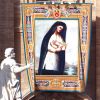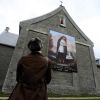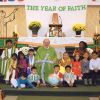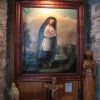Opening the door of faith
Betty was called mama ndi father (mother of priests) even though she did not have a son who was a priest. Actually Betty had no children of her own. Her husband left her for another woman 45 years ago because Betty could not bear children as a result of a terrible accident.
In traditional African society, few things are more painful and traumatic for a woman than being divorced or being barren. Betty’s world was shattered and during this time she lived in silent despair.
However, she had one thing going for her: she was a woman of faith who went to daily Mass and spent an hour every day with Jesus in the Blessed Sacrament.
Rejected by her husband, misunderstood by her friends, and even suspected by her family of being a bearer of bad fortune, she sought direction from God on what to do with her life. During those encounters with God, Betty felt a deep calling in her soul to devote her life to supporting priests and missionaries in her own little way.
So she answered that call, and spent the last 45 years of her life as a housekeeper in a rectory, as well as a lay catechist and an unofficial spiritual counsellor for priests, seminarians and laity. She became a mother-like figure to priests and seminarians and started to be called mama ndi father.
I came to her parish in 1997 as the head of a team of 15 seminarians who were trained in new evangelization by the local ordinary. Bishop Gbuju (now retired) had established the first school of new evangelization in Africa and encouraged many young seminarians to learn a new way to communicate the truth of our faith in a changed world. We came to Betty’s parish to practice what we had learned.
We would go to market squares and shopping malls and begin open-air preaching like Jesus did in His own ministry. We had megaphones that we used to good effect to make “holy noises” to attract attention. This type of preaching has to be boisterous to make people stop and listen.
On our first day, I recall being interrupted with questions like: “When did Catholics start preaching like Pentecostals?” “Your noisy preaching is disturbing public order!” One enraged vendor, claiming our preaching was disruptive and hurting his business, threatened to call police or take the law into his own hands.
That first day was very challenging but, when we came home, our mama ndi father was waiting to comfort and strengthen us. At 84, she could no longer cook because her bones ached from arthritis and she had begun to lose her memory. But she retained all her Christian charm and spiritual lucidity.
I don’t remember everything she said that evening, but I do recall two significant insights she passed along.
First, Betty said the door of faith was opened to humanity by Christ and our Christian calling is to pass through that door and to lead others to the door by how we live our lives. To do that we need God’s grace. She said her life, following the pain of her divorce and childlessness, became more meaningful because every day she passes through the door of faith.
Second, she took my hand as the head of the group and breathed on my palm and offered assurance that she would pray for me and the group because she knew that through prayer we would be able to touch people and lead them to the door of faith.
Betty was not a theologian, but she knew through personal experience the meaning of faith. Reading Pope Benedict’s apostolic letter introducing the Year of Faith, I thought of Betty. She taught me that faith means to centre our lives on Christ and that we should bring our dreams and challenges of life to the door of faith. It is in trusting God and bearing witness to the values of our Christian tradition that we create deep intimacy with God.
I also learned from Betty that the surest means of leading others through the door of faith is to lead an authentic Christian life. Above all, mama ndi father taught me that prayer is the clearest expression of faith because it brings the whole of life to the whole of God.
(Fr. Stan Chu Ilo’s latest book, Discover Your Divine Investment, is published by Catholic Register Books and is available by calling 416-934-3410.)
VATICAN CITY - Fortunetelling, like all occult practices, is strictly taboo at the Vatican; and prophecy is a rare gift among journalists. But Pope Benedict XVI's calendar for 2013 is already filling up with planned, probable or possible events. Here are 10 to watch for in the news during the coming year.
VATICAN CITY - When Christians remember their beloved deceased, they proclaim that their bonds with them are not broken by death and they profess their hope in eternal life, said Pope Benedict XVI.
Especially by visiting cemeteries and other burial grounds, the pope said, people "reinforce the bonds of communion that death could not break."
Pope Benedict celebrated a Mass Nov. 3 in St. Peter's Basilica in memory of the 10 cardinals and 143 archbishops and bishops from around the world who died in the past year.
The evening before, Pope Benedict had paid a private visit to the grottoes under St. Peter's Basilica to pray at the tombs of the popes buried there.
The November commemorations of All Saints and All Souls, as well as other memorial Masses traditional during the month, are not simply ways Catholics remember those who have gone before them, the pope said, but they also are expressions of Catholic faith in the reality of eternal life.
"Death opens to life -- eternal life, which is not an infinite copy of the present time, but something completely new," the pope said. "Faith tells us that the true immortality to which we aspire is not an idea or concept, but a relationship of full communion with the living God."
Remembering the deceased cardinals and bishops, he said, the church prays that the Lord will give them "the eternal prize promised to faithful servants of the Gospel."
Pope Benedict said the 10 cardinals and 143 bishops were the "meek, merciful, pure of heart, peace-making disciples" mentioned in the Beatitudes of the Gospel. They were "friends of the Lord who, trusting in his promises -- also in times of difficulty or even persecution -- maintained the joy of their faith and now live with the Father forever."
Reciting the Angelus Nov. 4 with pilgrims in St. Peter's Square, Pope Benedict said the saints are those men and women who tried to live the commandment to love God and to love their neighbors as themselves.
The pope said a deep, loving relationship with God is the best way to ensure that one becomes capable of loving others, "just as a child becomes capable of loving starting from a good relationship with his mother and father."
And just as parents love their children not only when they are being good, God always loves us and tries to help us see when and where we go astray, the pope said.
"From God, we learn to want to do only what is good and never what is bad. We learn to see others not only with our own eyes, but with the gaze of God," looking beyond the superficial to see the other person and what he or she needs, the pope said.
"Love of God and love of neighbor are inseparable," he said.
Kateri teaches us to have hope
St. Kateri teaches us our response in faith to Jesus Christ brings healing, said Edmonton Archbishop Richard Smith at a Thanksgiving Mass in Rome Oct. 22.
“Among the most striking aspects of her witness is the miraculous transformation of her face soon after her death,” said the president of the Canadian Conference of Catholic Bishops (CCCB) in his homily at St. John Lateran, Rome’s cathedral church. “From the age of four, terribly scarred by the smallpox, her face was restored to its original beauty only minutes after she had died.”
Smith noted Kateri said “Jesus, I love you,” just before she died, showing how her response to Christ’s love preceded the healing.
“How greatly do we need this lesson from Kateri today,” he said. “We may not bear physical scars, but so many today carry deep emotional and psychological ones.
“These are inflicted not by smallpox but by poverty, addiction, loneliness and betrayal. They are caused by the abuse suffered by Kateri’s modern-day sisters and brothers in their time at residential schools,” he said. “So much pain, so many emotional scars. Yet Kateri teaches us that no wound, however deep, should leave us without hope.”
The archbishop called the facial healing “an outward sign of the interior transformation that is given to all who hand over their lives to Christ, and who do so in love.”
The Mass, televised live by Salt + Light Television, drew more than 2,500 people, many of them Canadian pilgrims. Almost 20 Canadian bishops were present, including concelebrants Bishop Lionel Gendron and Auxiliary Bishop Louis Dicaire of Saint Jean-Longueuil, who serve the diocese that includes the Mohawk territory where St. Kateri died. The all-party delegation led by Canada’s Speaker of the House of Commons, Andrew Scheer, attended as did Canada’s ambassador to the Holy See, Anne Leahy.
“The meeting of God’s loving initiative with a grace-filled human response is on beautiful display in the life of St. Kateri,” said Smith, who said her name Tekakwitha was one of the earliest signs.
Tekakwitha has a variety of interpretations: “she who feels her way ahead,” “moving forward slowly,” “one who bumps into things,” but also “one who places things in order” or “to put all into place,” the archbishop said.
“It is, of course, true that Kateri’s physical sight was seriously compromised due to the smallpox from which she suffered,” he said. “What is equally true, however, and what is of far greater significance, is that her inner vision was clear.
“Deep within her heart she had received the gift of seeing clearly the truth of Christ and His Church. It is as if God, through the very name Tekakwitha and the life of the one who bore it, has drawn attention to the limits of human vision in order to point us to the true sight that comes from faith.”
Smith tied the canonization of North America’s first female indigenous saint with the Year of Faith and the Synod on New Evangelization taking place in Rome until Oct. 28.
“Kateri reminds us that this new evangelization, to be effective, must not only be proposed anew but also find an open and ready welcome in the heart of the recipient,” he said. “When the Jesuit missionary, Fr. de Lamberville, spoke of our Lord and the Christian faith, the Gospel message of life and hope found a home within her.”
He called Kateri’s response to the Gospel message a “work of grace.”
“Only with the help of God’s grace are we able, like Kateri, to make of our entire lives a living and pleasing sacrifice to God, as St. Paul exhorts us to do,” he said. “Only with divine assistance do we become, like Kateri, the mothers, brothers and sisters of Christ by doing the will of His — and our — heavenly Father.”
An estimated 1,500 Canadian pilgrims attended the canonization in St. Peter’s Square, most of them from First Nations and other aboriginal communities. Among the 17 Canadian bishops was Toronto Cardinal Thomas Collins.
“Throughout her short life, St. Kateri never abandoned her faith,” said Prime Minister Stephen Harper in an Oct. 21 statement.
“The canonization of St. Kateri is a great honour and joyous occasion for the many North Americans and aboriginal peoples who cherish her witness of faith and strength of character. The Government of Canada stands with those who are celebrating her life on this day in Canada, the United States and throughout the world.”
The canonization Mass Pope Benedict XVI celebrated Oct. 21 is available via the cccb.ca web site or at www.saltandlighttv.org.
Phil Fontaine lets politics get in the way of the truth
Native leader loses track of the facts at St. Kateri’s canonization
The making of saints is a joyous affair, with a gracious spirit abounding toward all, and a determined effort to ignore any discordant notes. I recall, for example, at the beatification Mass for Cardinal John Henry Newman my surprise at seeing Bishop Remi De Roo, the retired bishop of Victoria, sitting not a few paces away from Pope Benedict XVI. Bishop De Roo had been keeping a determinedly low profile since leaving his diocese plagued by financial scandal, so it was a surprise to see him at all.
Yet there he was, ebullient at Newman’s beatification, taking the great cardinal as inspiration for his own theological vision. The Holy Father, for his part, was inspired enough by Newman that he departed from his usual practice and conducted the beatification himself. Between Benedict XVI and Bishop De Roo there is a vast difference as to the proper interpretation of the Second Vatican Council and other theological matters, and the former would be astonished that the latter would claim Newman for his positions. But it was a beatification, the saints belong to the whole Church, and so the gracious thing to do was not to notice the incongruity of it all.
It is inevitable that new saints are used for partisan purposes by various factions in the Church. Sometimes the Holy See attempts to forestall the attempt to use the saints in this fashion, as for example when Pope John XXIII and Pope Pius IX were beatified on the same day, or when Pope John Paul II and Pope Pius XII were declared venerable on the same day.
The canonization of Kateri Tekakwitha on Oct. 21 was characterized — wittingly or not — in such factional terms by Phil Fontaine, former national chief of the Assembly of First Nations, who was present in Rome for the canonization. Fontaine had been in Rome in 2009, accompanied by Canadian bishops, to receive an apology for the treatment of native children in residential schools. So he speaks with some authority on relations between native peoples and the Catholic Church. But what he said in Rome cannot go unremarked.
“(The canonization) makes it possible, very much possible, to bring our community — the First Nations — very much closer with the Catholic Church. There was rupture for too long,” he told Catholic News Service.
“The canonization makes it possible to share our daughter with the universal Church,” he continued. “If you link the two events (the 2009 visit and the canonization), it is all about imparting reconciliation. It is an opportunity for us to say, ‘We accept your apology, we forgive, and so now let us begin taking the important steps of healing and reconciliation.’ ”
Healing and reconciliation need to be rooted in truth, and what Fontaine said is not rooted in the truth of Kateri’s life. Kateri’s choice to be baptized and practise her Catholic faith meant that her own people persecuted her, so much so that she left her native village in present-day upstate New York and moved to the Christian mission near Montreal, where she died at age 24.
As to whether she belongs to her native tribe or the universal Church, the answer is that she belongs to both. But if she was forced to choose, it is clear that Kateri would have chosen her faith. In fact, that is what she did at considerable cost.
More objectionable is Fontaine’s treatment of the canonization as a sort of super-apology, as if the Church gave native Canadians a saint to compensate them for their suffering. That would make Kateri an instrument of factional jockeying rather than a model of holiness. Moreover, it neglects the fact that in the complex history of the Church and native peoples, Kateri is an example of native persecution of Christians, not the other way around.
“St. Kateri was persecuted for the faith she held so tenaciously,” Prime Minister Stephen Harper said in his statement. The prime minister did not mention who persecuted her. Good manners today mean that we don’t mention the aboriginal peoples who made martyrs — sometimes brutally so — of Christians, but an objection must be made when Kateri is advanced as an occasion of “accepting” an apology from the Church. The truth of history is exactly the opposite.
Fontaine was a discordant voice in his remarks to Catholic News Service. Most voices — aboriginal and otherwise — did not see this as the latest installment of an ongoing conflict between natives and the Church, but a blessing for both. It was, and St. Kateri may well obtain from God the gift of reconciliation for the First Nations peoples, but reconciliation requires first that the truth be told.
A saint for today
It took 128 years from the launch of her sainthood cause for Kateri Tekakwitha to be canonized. That’s a long wait even by Church standards. But when Pope Benedict proclaimed St. Kateri on Oct. 21, the timing seemed perfect.
Kateri’s life of virtue and holiness was lived more than 400 years ago, but perhaps there has never been an era when her story was more relevant — or more important. In many respects the 17th-century heroine is ideally suited for these times.
Orphaned, disfigured by smallpox, ostracized for her beliefs, Kateri committed her life to works of charity and to Christ. Despite facing constant hostility, her faith was steadfast.
As we begin the Year of Faith, Catholics are being called to become proud and joyful disciples who give public witness to faith. In an era when Western culture is widely cynical about religion, Catholics are asked to re-connect with Church teaching and re-embrace Catholic values. They’re asked to confront an increasingly secular world with courage and conviction, to promote Catholic truths and to resist the secular forces of conformity.
Just as St. Kateri did.
“May her example help us to live where we are, loving Jesus without denying who we are,” Pope Benedict said at the canonization ceremony.
In particular, Kateri, who died at age 24, can be a model for Catholic youth. Young people need a counter influence to offset a pervasive media culture that constantly dismisses traditional morality in favour of hedonism and materialism. Kateri’s life demonstrated the virtue of living a life guided by prayer, sacrifice and charity.
She also showed that it’s not how you look, but how you live that’s important. Society today places perverse value on personal appearance. Looking good is a multi-billion-dollar industry that targets teens and young adults with an often-harmful message. Kateri’s story is a counter message that professes that true beauty is emitted from the heart, not reflected in a mirror.
Her face scarred and her eyesight damaged at an early age by small pox, Kateri stands as a symbol of strength and comfort for anyone persecuted or bullied because they are different. That message is important at a time when technology is making bullying easier than ever and when teen depression and suicide are rising. Kateri faced her tormentors. She refused to abandon her beliefs but instead answered a call to chastity and embraced Christ, even though it made her an object of scorn in her village.
As Quebec Archbishop Gerald Lacroix said, Kateri is an excellent role model for young people of how to live a “simple life, faithful to the Lord, in the midst of hostility.”
Kateri lived her faith proudly and proclaimed it joyfully. It’s a message worth spreading.
Canadians see St. Kateri's canonization as help for reconciliation
VATICAN CITY - After decades of resentment and horror over the abuse of indigenous children, the canonization of St. Kateri Tekakwitha marked a further step toward the reconciliation of the indigenous communities and the Catholic Church.
Phil Fontaine, former national chief of the Assembly of First Nations of Canada, told Canadian church and government officials the canonization "makes it possible, very much possible, to bring our community -- the First Nations -- very much closer with the Catholic Church. There was a rupture for too long."
Fontaine headed a 2009 Canadian aboriginal delegation to the Vatican, which received a formal apology from the church for the treatment of native children in Canadian residential schools.
An estimated 100,000 aboriginal children passed through the schools, which were abolished in the 1990s. They were established and paid for by the Canadian government, but were administered by various church organizations, including Roman Catholic dioceses and religious orders. The schools became known for widespread physical and sexual abuse of children and have been blamed for contributing to the disappearance of native languages and cultures.
Fontaine spoke at a reception after the canonization and Mass Oct. 21, addressing Canadian bishops, other First Nations leaders and a government delegation led by Andrew Scheer, speaker of the House of Commons.
Anne Leahy, Canadian ambassador to the Holy See, said the government delegation was a sign of just how much importance the government gave the canonization of St. Kateri, the first aboriginal saint from North America.
When Fontaine led the native delegation to the Vatican in 2009, he said, "we were blessed with a private audience with His Holiness (Pope Benedict XVI)," who gave the First Nations "great comfort. And now, here we are, three years later and we have another blessing: being witness to another very significant event," the official recognition of St. Kateri.
Her canonization, he said, "makes it possible to share our daughter with the universal church."
"If you link the two events" -- the 2009 meeting and the canonization -- "it is all about imparting reconciliation," Fontaine said.
The canonization, he said, "is an opportunity for us to say, 'We accept your apology, we forgive, and so now let us begin taking the important steps of healing and reconciliation."
Sylvain Chicoine, a member of the Canadian Parliament representing Chateauguay-Saint-Constant, Quebec, which includes the mission where Kateri died in 1680, told Catholic News Service the canonization is especially important in his region.
"They used to tell stories of Kateri in our schools, until about 30 years ago," he said. "Now the young will know her, too."
"Kateri made a bridge between the Europeans and the First Nations, and she can be an example today to rebuild bridges between our communities," which are still experiencing lingering tensions over land-use disputes from the 1990s, Chicoine said. "There is still work to do in repairing the relationship."
Elaine Johnson, a nurse and member of the Peter Ballantyne Cree Nation in northeastern Saskatchewan, said she came to Rome for the celebration because St. Kateri "is our first First Nations saint. We need to empower ourselves and she's our role model for being prayerful, humble and giving. As a First Nations person, I just wanted to be present."
"We as First Nations people would not look at her as having adopted European culture. Christianity does not take away our identity," she said. "I was born and raised a First Nations person and a Catholic, which empowers you because your ultimate goal is heaven. The church strengthens you."
Tobasonakwut Kinew, an Ojibway elder and university lecturer, came from Winnipeg for the canonization. A survivor of abuse at a residential school, he was part of the First Nations delegation that met the pope in 2009.
He told CNS, "I was sitting in a hotel in Thunder Bay (Ontario) in 1970 and was asking, praying, begging to be freed from alcohol and that's the last time I took a drink. I grew up praying to Kateri, and I used to think prayers were never answered, but here I am today."
Asked to write out his name for a reporter, Kinew did so, saying, "That's one thing I did learn at the residential school."
Pope proclaims seven new saints, including St. Kateri, St. Marianne
VATICAN CITY (CNS) -- Proclaiming seven new saints -- including St. Kateri Tekakwitha and St. Marianne Cope from North America -- Pope Benedict XVI said they are examples to the world of total dedication to Christ and tireless service to others.
In a revised canonization rite Oct. 21, the pope prayed for guidance that the church would not "err in a matter of such importance" as he used his authority to state that the seven are with God in heaven and can intercede for people on earth.
An estimated 80,000 pilgrims from the United States, Canada, the Philippines, Italy, Spain, Germany and Madagascar filled St. Peter's Square for the canonization of the holy women and men who ministered among their people.
The pilgrims applauded the proclamation of the new saints, who included: Kateri, an American Indian who was born in the United States and died in Canada in 1680; Mother Marianne, a Sister of St. Joseph who traveled from Syracuse, N.Y., to Hawaii to care for people with Hansen's disease and died in Molokai in 1918; and Pedro Calungsod, a teenaged Philippine catechist who was martyred in Guam in 1672.
The other new saints are: French Jesuit Father Jacques Berthieu, martyred in Madagascar in 1896; Italian Father Giovanni Battista Piamarta, founder of religious orders, who died in 1913; Sister Carmen Salles Barangueras, founder of a Spanish religious order, who died in 1911; and Anna Schaffer, a lay German woman, who died in 1925.
In his homily at Mass following the canonization, Pope Benedict prayed that the example of the new saints would "speak today to the whole church" and that their intercession would strengthen the church in its mission to proclaim the Gospel to the world.
The pope also spoke about each new saint individually, giving a short biographical outline and highlighting a special characteristic of each for Catholics today.
Pope Benedict called St. Kateri the "protectress of Canada and the first Native American saint," and he entrusted to her "the renewal of the faith in the First Nations and in all of North America."
The daughter of a Mohawk father and Algonquin Christian mother, St. Kateri was "faithful to the traditions of her people," but also faithful to the Christianity she embraced at age 20. "May her example help us to live where we are, loving Jesus without denying who we are," the pope said.
Archbishop Charles J. Chaput of Philadelphia, who is of American Indian descent, told Catholic News Service, "I think many young people today are embarrassed about embracing the Catholic faith because they live in a secular culture that's hostile toward religious experience."
St. Kateri also "grew up in a place where there was great hostility toward Christianity," Archbishop Chaput said, but she resisted all efforts to turn her away from her faith, "so in some ways she would be a model of fidelity in the face of persecution on religious freedom grounds."
Archbishop Gerald Cyprien Lacroix of Quebec told CNS that the canonization of the first aboriginal of North America is "huge for us." St. Kateri, he said, is an excellent model for young people of "living a simple life, faithful to the Lord in the midst of hostility."
St. Kateri's life and canonization show that "saints don't have to do extraordinary things, they just have to love," Archbishop Lacroix said.
Francine Merasty, 32, a Cree who lives in Pelican Narrows, Sask., said, "Kateri inspires me because she's an aboriginal woman. According to sociologists, aboriginal women are at the lowest (social) strata, and for the church to raise up to the communion of saints an aboriginal woman is so awesome and wonderful."
Jake Finkbonner, the 12-year-old boy from Washington state whose healing was accepted as the miracle needed for St. Kateri's canonization, received Communion from the pope during the Mass. Jake's parents and two little sisters did as well.
Speaking about St. Marianne of Molokai in his homily, Pope Benedict said that a time when very little could be done to treat people with Hansen's disease, commonly called leprosy, "Marianne Cope showed the highest love, courage and enthusiasm."
"She is a shining example of the tradition of Catholic nursing sisters and of the spirit of her beloved St. Francis," the pope said.
Leading a group of Hawaiian pilgrims, including nine patient-residents from Kalaupapa, where St. Marianne ministered, Honolulu Bishop Larry Silva said St. Marianne is "an inspiration for those who care for those most in need, which is what all Christians are called to do. Now, with universal veneration, she can inspire people around the world."
With thousands of Philippine pilgrims in St. Peter's Square, Pope Benedict praised St. Pedro, a catechist who accompanied Jesuit priests to the Mariana Islands in 1668. Despite hostility from some of the natives, he "displayed deep faith and charity and continued to catechize his many converts, giving witness to Christ by a life of purity and dedication to the Gospel."
The pope prayed that "the example and courageous witness" of St. Pedro would "inspire the dear people of the Philippines to announce the kingdom bravely and to win souls for God."
Pope Benedict also cited St. Anna Schaffer as a model for a very modern concern.St. Anna was working as a maid to earn the money for the dowry needed to enter a convent when an accident occurred and she "received incurable burns" which kept her bedridden the rest of her life, the pope said. In time, she came to see her pain and suffering as a way to unite herself with Christ through prayer, he said.
"May her apostolate of prayer and suffering, of sacrifice and expiation, be a shining example for believers in her homeland, and may her intercession strengthen the Christian hospice movement in its beneficial activity," the pope said.
- - -
Contributing to this story was Francis X. Rocca.
- - -
[issuu width=420 height=258 printButtonEnabled=false backgroundColor=%23222222 documentId=121018202102-3c059b87113a4d82ba02989f22b40f1a name=kateri username=catholicregister tag=special unit=px v=2]
You can enjoy the features below about St. Kateri Tekakwitha on CatholicRegister.org.
St. Wilfrid’s opens a diverse Year of Faith
TORONTO - The Year of Faith kicked off Oct. 14 in a multicultural way for one of the most culturally diverse parishes in a city known for its cultural diversity.
At the noon Mass, St. Wilfrid’s Church in northwest Toronto joined other parishes across the archdiocese in kicking off the Year of Faith, but in a way that reflects the face of its parishioners.
“The Year of Faith was inspiration the Church received to reflect on our faith but also on our diversity,” Fr. Massey Lombardi told those gathered.
“There’s about 45 different languages in this parish but I would think if you went to other parishes in the city you would find the same thing.”
To celebrate the cultural melting pot that is his parish and city, Lombardi hung about 40 miniature flags on the walls surrounding the altar. These flags represent the heritage of the parishioners who attend his services weekly. On this Sunday the church, brightened by the colourful attire worn by many, was filled beyond its 1,000-occupancy capacity with parishioners lining the back wall and spilling out into the foyer.
“Those flags are going to stay up all year and we are going to have programs that speak of the diversity,” said Lombardi. “This parish here is very diverse and we want to celebrate that. It’s really trying to build an understanding of cultures and respect.”
Fol lowing communion Lombardi invited parishioners to offer a sign of peace and recite the Our Father in their native language. After the service parishioners headed to the parish hall to sample lunch dishes as diverse as the cultural attire they donned, sharing their diversity as one community.
“It’s both a joining together and sharing food and there is nothing like joining together to share food,” said Lombardi.
Lombardi said plans are in the works to expand this all-encompasing atmosphere outside of the church’s walls.
On Oct. 21 the parish will dedicate a statue to St. Padre Pio.
“This is really a segue into all the other things we can do in terms of our liturgy, in terms of our practice, our programs, but also in terms of our outreach to the poor, sick and the marginalized in our community,” said Lombardi. “Faith is not faith in the vacuum, it’s promoted, it’s increased, it’s deepened through cultures.”
Kateri celebrations in for long run at Ottawa school
Students at an Ottawa elementary school will be getting a full-day pass from the regular classroom in order to go to school on sainthood when Kateri Tekakwitha is canonized.
On Oct. 22, the day after Kateri is made a saint by Pope Benedict XVI in Rome, Blessed Kateri Tekakwitha Elementary School students will put away their math books and readers to spend the whole day studying St. Kateri and the process of canonization. They’ll watch videos from the Oct. 21 ceremony in Rome, hear about the school’s connection to Kateri and learn about her extraordinary life and culture from former teacher Line Douglas.
“She lived her faith and was devoted to others, caring for the elderly and the infirm while the others went about their business in the spirit of love and simplicity,” said Douglas, 70, explaining what she’ll tell the students. “She was so intense and so devoted. She was in love with the sublime, with God and did everything in such an admirable, straightforward, pure way.”
The day of learning is part of a two-month school celebration that will culminate when the school is renamed Saint Kateri Tekakwitha in late November. Similar renaming ceremonies will also occur at Blessed Kateri Catholic Elementary School in Hamilton, Ont., Blessed Kateri Tekakwitha Catholic School in Toronto and Kateri Tekakwitha Catholic Elementary School in Markham, Ont.
But the Ottawa school is taking things a step further.
“We’ve got multiple events,” said principal Paul Gautreau. “We’re using it as an opportunity for our kids to learn about Kateri and learn about what is a saint.”
The program started after the Thanksgiving long weekend when the student body, about 200 strong, were asked daily questions about Kateri, he said.
“We really want students’ voices to come through. We aren’t necessarily looking for the right answer, we want to know what they know as a starting point.”
Douglas, a descendent of the Mohawk nation, began teaching at Blessed Kateri in 1986 when the school opened. She retired in 1998. During her tenure at the school, Douglas worked hard to teach her students about Kateri’s devotion, dedication to faith despite social oppression and love of nature.
“I hoped that she rubbed off on me,” said Douglas. “I just love Kateri. I have a devotion to her.”
In the month leading up to the renaming of the school, a member of the Mohawk nation will frequent the Ottawa school to deepen the children’s knowledge of Kateri. They’ll study native culture and the challenges Kateri faced practising her faith in a 17th-century native culture.
They’ll also learn native drumming, which they will perform during the Nov. 29 renaming ceremony where traditional aboriginal refreshments and snacks will be served.
“Part of the reason for (the Nov. 29 date) is that many of people who we are going to ask to come here will actually be in Rome for the canonization,” said Gautreau.
Those who will be in Rome include Ottawa Archbishop Terrence Prendergast, a Mohawk leader and an Algonquin leader who once owned the land the school is located on.
Gautreau said he hopes the lessons continue after the school is renamed because he feels there is a lot his students can learn about their faith from Kateri.
“I hope that these celebrations will provide a little spark that will help things to just keep moving forward,” he said. “She was extremely faithful in challenging circumstances in that she renewed her faith in those challenging circumstances. That’s a message we can hopefully bring to the students.”
Patience, love guided Kateri’s promoter
VATICAN CITY - Although separated from her by three centuries, an ocean and major cultural differences, Jesuit Father Paolo Molinari absolutely loves Kateri Tekakwitha, the Native American who becomes a saint Oct. 21.
While the 88-year-old Italian Jesuit was forced to give his successor most of the sainthood causes he still was actively promoting when he turned 80, “thank God, they let me keep Kateri.”
Molinari, one of the Church’s most prolific postulators — as the official promoters of causes are called — inherited Kateri’s cause from his Jesuit predecessor in 1957. He shepherded her cause to beatification in 1980.
“I love her. She’s a lovely young lady indeed,” said the Jesuit, his eyes sparkling.
Molinari said his admiration for Kateri, combined with the complex Vatican process for declaring saints and the fact that she died some 330 years ago, gave him 55 years to practice the virtue of patience. But unlike many of the so-called “ancient causes” that are surrounded by pious legends, but lacking hard evidence, Kateri’s cause was supported by plenty of eyewitness accounts of her life, faith, good works and death.
The Jesuit missionaries who baptized her in 1676 and provided her with spiritual guidance until her death in 1680 at the age of 24 wrote formal annual reports about their missions to the Jesuit superior general. Kateri, known as the “Lily of the Mohawks,” is mentioned in many of the reports, which still exist in the Jesuit archives, he said.
Molinari also had access to the Jesuits’ letters that spoke about Kateri in glowing terms and to biographies of Kateri written by two of the Jesuits who knew her at the Mission of St. Francis Xavier in what is now Kahnawake, Que. Frs. Pierre Cholenec, her spiritual director, and Claude Chauchetiere, who also did an oil painting of Kateri shortly after her death.
Kateri was born to a Catholic Algonquin mother and a Mohawk father in 1656 along the Hudson River in what is today upstate New York.
After her baptism, Molinari said, “she kept living the life of a normal Indian. She continued to be an Indian young lady, and yet she did it with the spirit of the Gospel: showing goodness and tenderness to people who were in need.”
She suffered from light sensitivity after contracting smallpox, so would spend much of her time inside. She prayed and made garments out of hides for those who were unable to make their own, he said.
Molinari said that although the cause was challenging at times, he kept working for Kateri’s canonization because of her importance to the native peoples of North America.
Kateri is a model who can “help those who are Christian live the Gospel in their own culture.”
The Catholic Church, he said, “is the first organization that has acknowledged the richness of one of their own people. The U.S. and Canadian governments have never done anything like that.”
Once Kateri was beatified, Molinari’s efforts turned to helping more people learn her story, encouraging people to trust that she could intercede with God to help them and finding an extraordinary grace that could be recognized officially as a miracle granted by God through her intercession.
The Jesuit said that in the sainthood process, miracles are “the confirmation by God of a judgment made by human beings” that the candidate really is in heaven.
In Kateri’s case, the recognized miracle was the healing of five-year-old Jake Finkbonner from a rare and potentially fatal disease, a flesh-eating bacteria called necrotizing fasciitis. The boy and his family are members of St. Joseph parish in Ferndale, Wash., in the Seattle archdiocese.
“Kateri lived 300 years ago and yet she is widely remembered with love and admiration to the point that people believe she is certainly with God because of the way in which, as an Indian woman, she opened herself to the grace of God, became a Christian and lived as a Christian,” he said.
People are convinced that God listens to her and that “she always listens to those in need, just as she did in life,” he said.
Kahnawake embraces Kateri’s spirit
KAHNAWAKE, QUE. - The small Catholic community of St. Francis Xavier Church, with the St. Lawrence River and sprawling Montreal as its backdrop, has enthusiastically prepared for the canonization of Blessed Kateri Tekakwitha.
Located in Mohawk territory in Kahnawake, the church enshrines the remains of Blessed Kateri, a native woman who found refuge and spiritual renewal in the region where she spent her final days as a Catholic. Her remains lay beneath a marble tomb in the church, entombed primarily to ensure their safety and respect, as someone had previously attempted to steal them many years ago.
Pilgrims can kneel and pray or light a votive candle with Blessed Kateri’s likeness on it. The image is based on an oil-on-canvas painting, housed in a room beyond the gift shop, painted by Jesuit Father Claude Chauchetiere, the pastor of St. Francis Xavier Mission from 1677 to 1688, and a witness at Blessed Kateri’s death.
In a gift shop adjacent to the church, Kahnawake native Ann-Marie Sky talks about the importance of Blessed Kateri’s example not only for herself, but for the survival of the parish.
“For me, it’s her spirituality and her perseverance during the time and after she became Catholic. She was ostracized for that, so her faith really carried her through,” Sky said. Similarly, the parish has had to learn to persevere just to keep the church doors open.
“The church almost had to close a year and a half ago due to finances,” Sky explained. “We were just working our way back up and we got the news that she will be canonized, so now we’re really trying to keep the church afloat.”
For a parish that only sees about 60 regular Mass-goers on Sunday mornings, the annual $25,000 price tag for utilities to heat and use the church has been a challenge. But with great faith and ambitious fundraisers, it has managed to pay the bills. And since the announcement that Kateri would be canonized on Oct. 21, making her the first North American aboriginal saint, the parish has seen nearly three times the number of pilgrims it normally sees. The demand for Kateri merchandise has risen and Sky is trying to stock enough merchandise before Oct. 21, when the mission expects busloads of visitors to join parishioners for a re-broadcast of the canonization in Rome.
The Pope’s Feb. 18 announcement of Kateri’s canonization came as a surprise.
“I couldn’t believe it, because after Brother André was canonized, I didn’t think there would be anybody else from Quebec canonized for another 20 years,” Sky said.
And not only in Quebec, but from the same area, she added. From the church in Kahnawake, the dome of St. Joseph’s Oratory on Mount Royal — the legacy of St. Brother André — is easy to spot across the river on a clear day.
Like Sky, Kahnawake resident Beverly Delormier has been working diligently to prepare for the big day, although Delormier will be spending it in Rome.
“I was there in 1980 with my daughters when she was beatified and never in my wildest dreams did I think that I would go there again for the canonization,” marvelled Delormier. “The day of the beatification everybody had their native dress on, so it was really something spectacular to see.”
For Delormier, Blessed Kateri is an important intercessor.
“It’s all little things, but I believe in the power of prayer.”
Deacon Ron Boyer, Canadian vice-postulator for the canonization of Kateri, says her canonization is long overdue. But more importantly, the canonization brings to light God’s desire to reach the aboriginal people.
“Her first miracle happened about 15 minutes after she died,” Boyer said, referring to the historical accounts of Kateri’s transformation. Kateri had contracted smallpox as a child and was left partially blind and covered with facial scars. Minutes after her death, any trace of her scars vanished and her appearance was described as beautiful.
“Why would God glorify a dead body? Why? Nobody has been able to answer that for me, but I believe He did it to show us that there is a God,” Boyer concludes.
Boyer adds Kateri is also significant for her impact on Christians and non-Christians alike.
“Many non-Catholic aboriginal people are going to Rome to pay homage to Kateri. She was special, a lady of many qualities,” Boyer said. “She is also the empress of ecology and a symbol for the youth.”
As the diocese of Saint-Jean- Longueuil is not immune to the shortage of priests in Canada, St. Francis Xavier has a pastor, Fr. Raymond Esprit, who is present only three days per week. Boyer hopes the canonization and increased traffic might mean a permanent priest in the future.
In the meantime, the canonization has already served to strengthen ties within the Kahnawake community. A committee from the parish has been working with the diocese to prepare for the big day, as well as a thanksgiving Mass to be held at St. Joseph’s Oratory on Nov. 4.
Saint-Jean-Longueuil diocese is sending 200 pilgrims to Rome.
“For the native communities and for the larger community in North America, the canonization is extremely important because of her status as the first native woman of our continent to be recognized as a saint,” said Auxiliary Bishop Louis Dicaire. “We have been surprised by the interest from the general population of our diocese, often among young people 25 to 30 years old. Kateri is providing a source of inspiration.”
Although children do not receive formal Catholic education through the Quebec school system, volunteers at the Shrine say visits from area schools are on the rise and children learn about the woman whose name graces the local hospital, school and nearby island.
(Girard is a freelance writer in Ottawa.)
Boy’s recovery a Kateri miracle
When then five-year-old Jake Finkbonner showed up to play his last basketball game of the season in Ferndale, Wash., he had no idea it would change his life and lead to events that would culminate in the canonization of a saint.
St. Kateri Tekakwitha: a life of faith
Twice a refugee. Twice an orphan. An outsider among her own people. Kateri Tekakwitha lived in a time of war, famine, disease and turmoil. She was baptized at 20 and dead at 24 but lived such an extraordinary life of faith, courage and hope that the Church has now invested its hope in her, declaring her the first North American aboriginal saint, patron of ecology and ecologists, of exiles and youth.
St. Peter’s Square will look very different when Pope Benedict XVI declares Blessed Kateri a saint Oct. 21. Hundreds of native North Americans in traditional beads, feathers and blankets, carrying drums and wampum belts, will fill the heart of the Vatican. In the often painful history of the Church’s relationship with the original people of this country, there’s never been a moment quite like this.
“it’s very affirming and definitely gives us a whole new perspective on our sense of belonging in the Church,” said Sr. Kateri Mitchell, executive director of the Kateri Conference National Centre in Great Falls, Montana.
There will be all kinds of attempts to claim Kateri. Canadians will claim her as a native Canadian who lived and died in New France.
“This will be a great day for Canadian Catholics and a deep honour for our country,” said Prime Minister Stephen Harper when plans to make the Lily of the Mohawks a saint were announced in February.
The Jesuits also have a legitimate claim, having begun their efforts to have Kateri declared a saint more than 100 years ago.
“The Jesuits consider her one of theirs,” said Jesuit archivist Fr. Jacques Monet.
It was two 17th-century Jesuits, Fr. Pierre Colonec and Fr. Claude Chauchetiere, who wrote the first biographies of Kateri. Chauchetiere painted a portrait of her a few years after her death. It was the Jesuits who sheltered her at their mission in Sault Ste. Louis in 1677.
Though she is the Lily of the Mohawks, “It’s not going to be just the Mohawks there (at the canonization),” said Ojibway elder Rosella Kinoshameg a week before she was to fly to Rome with a delegation of mostly Mohawk followers of Kateri. Kinoshameg is a member of the Canadian Catholic Aboriginal Council, the official liaison between Canada’s Catholic bishops and aboriginal Catholics.
There are native people from across North America who identify with Kateri.
“She was born in 1656, died in 1680,” said Mitchell. “There wereno countries, no boundaries at that time. We had our own Turtle Island, which is North America. I just consider her a North American indigenous person.”
But once a saint, Kateri is a saint for the entire Church and an example to the whole world.
“It is a recognition by the Catholic Church of the holiness that exists among the native peoples,” said Monet.
There have been at least 300 books published about the life of Kateri, but few take seriously the historical and cultural circumstances of her life in the middle of the 17th century. A second look at Kateri leads to the conclusion that her fervent, mystical embrace of Christ was never a rejection of traditional Mohawk beliefs but rather a fulfilment of them, writes Mohawk historian Darren Bonaparte.
The tragic results of colonization struck Kateri early in her life. The European smallpox virus raged through her community the winter of 1661-1662. It killed her parents and her baby brother, and left her nearly blind with extreme sensitivity to light.
Kateri was born into wars that raged for control of the fur trade. Her Turtle Clan Algonquin mother, Tagascouita, had been captured in a Mohawk raid on Trois-Rivieres in then New France. By this process Tagascouita became Mohawk and was married to a Kenneronkwa, a war chief. She was born in Ossernenon, a village of the Iroquois Confederacy more than 360 kilometres south of Montreal in modern day New York State.
In the aftermath of the smallpox epidemic, Kateri was adopted by her maternal uncle, a chief of the Turtle Clan.
When she was 10 years old the French army launched an expedition into Mohawk territory to put a stop to Mohawk raids against the Huron, who were allies and trading partners with the French. The Mohawks were selling their furs into the Dutch network of trading posts around modern-day Albany and Schenectady, New York. It took the French a couple of tries, but they eventually looted and burned the village where Kateri was living at the time, Kahnawake or “At the Rapids.”
The French victory opened the door for Jesuit missionaries to move into Mohawk villages. The Jesuits learned the Mohawk language and were careful to ensure converts truly embraced the faith of their free will. Most converts were not baptized until near the end of their lives.
The new religion was splitting Mohawk villages. Kateri was in the middle of the split. Her father opposed the French and their religion. Another chief, Kryn the Great Mohawk, took more than 40 people with him to the Christian village of Kahentake near Montreal in 1673, including Kateri’s older sister.
Her adopted father forbade Kateri from going near the missionaries in an attempt to keep what was left of his family and his village together. But the girl knew her mother had been Christian and contact with the Jesuits became almost inevitable. Stuck in the village one day in 1675 with an injury, unable to work the land with the other women, Kateri ran into Fr. Jacques de Lamberville — a new missionary still trying to learn a very foreign language.
Lamberville baptized her with the name Catherine, after Catherine of Siena, Easter Sunday, 1676.
Meanwhile Kateri’s adoptive parents had been arranging a marriage for her. Marriage was the first and most important obligation of every Mohawk girl to her community. Kateri’s refusal to marry could have only shamed her uncle. Her Jesuit biographers report that the entire village turned against young Kateri.
In 1677 Kateri’s sister sent her husband into the Mohawk Valley. At 20 Kateri was off on a perilous journey with her brother-in-law through Lake Champlain and eventually back to the Christian village of Sault Ste. Louis on the shore of the St. Lawrence River.
In her new village, Kateri formed a close bond with an older woman named Kanahstatsi Tekonwatsenhonko, who became like another mother to her. Kateri also made friends with a young widow named Wari Teres Tekaienkwenhtha.
Kanahstatsi and Kateri’s older sister in Sault Ste. Louis began to pressure Kateri to marry, but the younger woman was fascinated by the life and witness of French nuns. The Jesuits argued native converts were too young in the faith to join an order of nuns. Denied that possibility, in 1679, on the Feast of Annunciation, Kateri made a personal vow of perpetual virginity.
Kateri and her friend Wari Teres became central figures in a movement of young women who took up extreme penitential practices in imitation of the Jesuits. Mostly symbolic self-flagellation was a normal practice among Jesuits of the time. The young women took it to extremes, and none more extreme than Kateri.
Kateri was frail, malnourished and tiny. The penitential practices likely took their toll. On Holy Thursday, April 17, 1680, her dying words were, “I love you, Jesus.”
“Then her face suddenly changed,” wrote the Jesuit missionary Cholenec. “It appeared to be smiling and devout and everyone was extremely astonished. We were all admiring her face and we could not have tired ourselves of looking at her.”
The scars that had marked her since her brush with smallpox seemed to disappear.
For many native people, the Holy Father’s declaration of sainthood for Kateri will only bring Rome up to date. Devotion to her has been building for generations among native North Americans who have long thought of her as their saint.
The native-focussed parish in Thunder Bay, Ont., is called Kitchitwa Kateri. Kitchitwa is the Ojibwa word for holy, blessed or sacred. Since there’s no separate word for saint, the parish will continue to be called Kitchitwa Kateri after her canonization, said Jesuit Father Larry Kroker.
Kinoshameg remembers praying for Kateri’s canonization as a school girl in the 1960s. As a young woman she attended Kateri prayer weekends and over the years she’s been to several Tekakwitha conferences in the United States and Canada. For as long as she can remember, Kateri has been part of Catholic native spirituality.
Though many native parishes seem to be dominated by elders, Kinoshameg believes devotion to Kateri will continue among those under the age of 25.
“I would hope young people would see that here is a young woman who has to be strong and be brave — really brave with all this turmoil going around,” she said.
The story of Kateri gives an example of perseverance that can only help young native people, said Kinoshameg.
“(Kateri) has a significant role to play in the future of the Catholic native Church insofar as she’s young,” said Jesuit Father David Schulist, director of the Anishinabe Spiritual Centre near Espanola, Ont.
The next generation needs to see themselves in the Church.
“There is now somebody they can refer to. Their lives are not seen entirely looking or gazing at a Eurocentric kind of faith,” Schulist said.
To get ready for the canonization, Campion College campus minister Stephanie Molloy organized a mini-pilgrimage on Oct. 10 through downtown Regina for 47 inner city students from Sacred Heart Community School. A large percentage of the students are aboriginal. The kids loved it.
“Definitely there’s the link with young people. She’s the patron of ecology and things that young people care about,” said Molloy.
That connection with youth was central to Pope John Paul II’s thinking when he beatified Kateri in 1980. In 2002 he would make her one of the special patrons of World Youth Day in Toronto.
John Robinson, an elder from Toronto’s Native People’s parish, will be one of about 180 native people from Ontario alone in Rome for the canonization. This begins a new chapter, he said.
“A lot of native people in cities and outside of cities are going to look to Kateri as a saint in a special way,” he said. “This is our first native saint and they’re going to have a lot of respect for it.”
The best of both worlds
What is our favourite TV show? Do we allow our children to read and watch The Hunger Games? What style of clothing do we choose? How much time do we spend online, and how do we spend it?
Every day, we are influenced by a culture that was rooted in Christianity but is now shaped by a radical secularism and a need for instant gratification. How are we as Catholics called to live in a culture that has not only forgotten its evangelical roots but often denigrates or even opposes them?
St. Kateri Tekakwitha offers valuable insights into this question by her intense commitment to Jesus Christ at a time when native cultures were confronted and often oppressed by European cultures.
Born of an Algonquin mother and Mohawk father, Kateri courageously bridged the gap between her own First Nations cultures and French Catholicism, embracing the best of both. Even her name highlights this characteristic: “Kateri” is a Mohawk version of the French “Catherine.” In embracing both her native heritage and Christianity, Kateri discovered and lived fully her deepest identity, expressing it in her total commitment to the Person of Christ.
Kateri’s intense love for Christ inspired her to follow Him wholeheartedly, both in prayer and in works of charity. But her ardour stirred up the animosity of many in her home village. Initially petty, the hostility escalated into real persecution — from children taunting her and throwing rocks, to her family refusing to allow her to eat on Sundays when she took extra time to pray, to death threats.
Instead of scaring her into a compromise, Kateri’s Mohawk upbringing inclined her to regard bravery in suffering as a sign of spiritual strength. She didn’t just accept suffering as part of life, but embraced it, wanting to share in the Cross of Christ for the sake of her people. Only after repeated death threats did Kateri reluctantly decide to flee to where she could live her faith freely.
Upon arriving at Sault St. Louis, the Christian native village in present day Kahnawake, Kateri’s fervour in prayer and generous kindness quickly made her a spiritual leader. She loved to pray in the Jesuit chapel, arriving first for Mass early in the morning, but she also prayed in the outdoor “chapel” she created by carving a cross into a tree trunk. Even the austere penances she practised were an expression of her love for Christ.
Kateri’s intense love for Jesus led her to embrace the counter-cultural call to virginity. Marriage was such an important value in her native culture that both in her home village and in the Christian village, Kateri faced innumerable pressures to marry. (Even her Jesuit mentors did not initially encourage her.) Her inexplicable fidelity to virginal chastity can only be explained by a call from God.
As her understanding of Christian life matured, Kateri’s desire for chastity flowered into a vow of virginity. Kateri is the first native woman of North America known to make this vow. Virginity was her vocation, her “way of love” in the world, and only in becoming a Catholic could Kateri discover and live the fullness of her vocation.
Immersed in her own culture, but not enslaved by it, Kateri’s reception of Christ’s saving love enabled her to develop her deepest identity. Affirming her First Nations heritage kept her rooted in her own culture, but also helped her follow a personal call and make the courageous choices for Baptism and consecrated virginity.
St. Kateri is a remarkable model for how we can engage in our culture today. She showed us how to claim our own heritage, embracing the values that strengthen our deepest identity and foster our commitment to Christ; how to discerningly engage with culture, aware that our unique identity is shaped by culture and also by God; and how to view every people and culture with the eyes of Christ, discovering common human values and the seeds of the Gospel even in the midst of conflict.
St. Kateri Tekakwitha, saint of the New Evangelization, pray for us!













